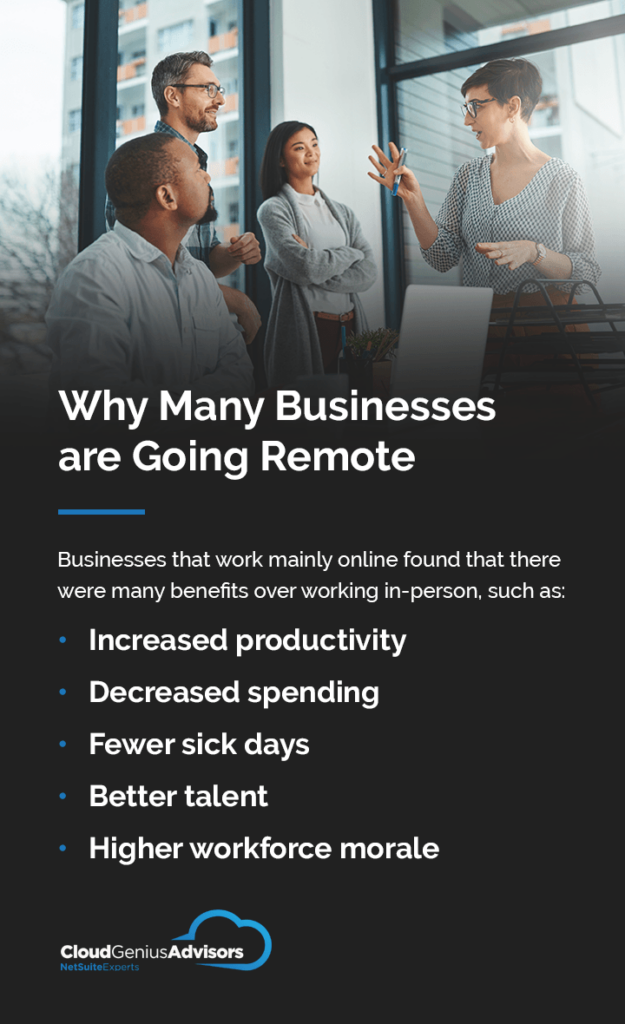The professional world is making a shift towards a remote workforce, and the change does not seem to be slowing down any time soon. Since 2020, 62% of workers operate remotely at least some of the time. For some industries, like transportation or food service, it is necessary to work on location. Thanks to advancing technology, other industries require only an internet connection and some computer equipment to get the job done.
If your staff plans on working remotely, then it is necessary to adjust your operations and educate your team on remote workforce best practices. Continue reading to learn how to approach and manage remote employees so that your business can continue to thrive just as it did when your staff was in-person.

Why Many Businesses are Switching to the Remote Workforce
The Covid-19 pandemic is largely responsible for the move towards the remote workforce. With health and safety concerns, businesses were forced to figure out how their teams could operate from their homes. Even though the need for remote working has lessened, some workforces are staying put, in the comfort of their homes.
Businesses that work mainly online found that there were many benefits over working in-person, such as:
- Increased productivity: Employees with the option to work from home are 47% more productive on average.
- Decreased spending: Some businesses can cut down on spending for everything from rent to office supplies.
- Fewer sick days: Employees working from home are less likely to take a sick day because they are already in their own homes. Plus, less office time means less germ-spreading between coworkers.
- Better talent: Before the remote workforce trend, companies were forced to choose from a smaller pool of local residents. Now, employers can hire the best person for the job, even if that person lives across the country.
- Higher workforce morale: Team members are likely to have a better balance between work and life when they do not have to report to their jobs.
Challenges Remote Workforces May Face
There are multiple reasons moving to a remote workforce might be challenging. From communication barriers to different work hours, there are some disadvantages to working from home. Common challenges faced by remote workforces include:
- Less supervision: Remote working means less oversight of employees. Less supervision and guidance may lead to less efficiency.
- More distractions: Home can be a distracting environment for a person trying to concentrate. Interruptions become more frequent from pets, children, or roommates. Meetings are more likely to be disrupted by doorbells, deliveries, etc. To better manage remote employees, screen-monitoring software can help.
- Limited communication: When working in an office, it is easy to seek out coworkers when you have a question. When a team works remotely, they may be online at different times throughout the day. This can cause longer gaps in communication and slow down productivity.
- Lacking company culture: Reinforcing company culture is easier with management and staff working closely together. When team members are all working from different locations, there are fewer opportunities for promoting culture.
- Dealing with technical issues: When working remotely, there is not an on-site information technology professional to help you deal with computer issues. Internet or laptop issues can interfere with a worker’s ability to complete tasks.
- Hiring without meeting in person: As hiring managers are working remotely themselves, the hiring process is becoming totally digital. The problem? No in-person interviews or meetings to see if someone is the right fit. Instead, portfolios, video meetings, and referrals are the only ways to learn about a new candidate.
Types of Remote Workers
There are many different kinds of remote workers. Some employees might bounce between remote working and coming to the office, while others work entirely from their homes. To approach managing a remote workforce, you should understand the variations and see which styles work best with your company. The following are types of remote workers and how they get their jobs done:
Hybrid Workers
A hybrid workforce has the option of either coming into the office or working from home. Some employees may commute to work certain days of the week or month and work remotely otherwise or vice versa.
Companies with partially remote staff are considered part of the hybrid remote category. Hybrid workers do a medley of remote working and in-person working. Managing a hybrid workforce means sometimes having both in-person and off-site employees at once.
Fully Remote Workers
Fully remote workers are employees that do their work entirely remotely. These workers never go to an employer’s offices or workspaces. Instead, they operate wholly from somewhere with wifi, usually their homes or coffee shops.
Some businesses operate entirely remotely. This means that everyone from executives to entry-level hires works digitally. In 2021, fully remote businesses are more present than ever before. Some businesses that were formerly in-office have converted to fully remote operations after seeing how cost-effective the switch was for their company.

Remote Independent Contractors
Independent contractors and freelancers alike are hired by clients to fulfill some of their working needs. Oftentimes, these contractors will work from home and for multiple businesses.
Some examples of remote independent contractors include:
- Copywriters
- Transcriptionists
- Marketers
- Travel agents
This category has worked remotely for years, even before the Corona virus pandemic.
After-Hours Workers
After-hours workers refer to staff that commute to work in the evenings as opposed to during the typical nine-to-five hours. These workers are not working from home, but from the office after the rest of the team has left for the day.
After-hours workers largely like the quiet and get their work done more efficiently alone in the office.
Traveling Workers
Traveling workers are employees such as marketers or sales representatives that travel to clients for their employer. These positions are largely in the B2B sector and require in-person meetings or demonstrations to close deals.
These remote workers are out of the office for their employer.
How to Manage the Remote Workforce
The shift to remote working does not have to be complicated or mean less efficiency for your business. If you want your team to succeed, you need an understanding of how to manage remote employees and how to set them up to win.
We compiled a list of six of the most helpful tips for handling a remote workforce and maintaining everything from employee morale to productivity. Keep reading to learn about the best practices that will help your team members thrive no matter their location.
Make Sure Your Employees are Properly Equipped for the Remote Workforce
Part of the reason a company allows its staff to work from anywhere is because of the accessibility to technology. Anyone expected to work from home must have the right equipment to get their tasks completed up to standard and on time. Before sending your team on their way, make sure you have the proper software for a remote workforce. Potential equipment needs include:
- Reliable laptops or computer monitors
- Mobile phones
- Subscriptions or applications
- Industry-specific software or tools
- Communication tools
Being technologically equipped is only half of it. Your team should also feel mentally equipped to work outside the office. Make sure each employee understands how to do their job remotely. They should have confidence using the software and instruments that are necessary to do their job, even from home.
Check with your team member to make sure they are fully equipped to work remotely before they start. You would not want a lack of supplies preventing someone from doing their job.
Knowing how to communicate is part of feeling equipped. Make sure all members of your team know the best communication practices for your business, whether that is via an app like Slack or by email. Your team should also understand that professionalism is necessary whether they are meeting from their living room or the office.
Set Clear Policies and Expectations
One of the best practices for managers is setting policies and expectations that are crystal clear for their staff. There should be no questions about the following:
- Deadlines: Employees should know exactly when projects and assignments need to be completed. There should be a definite day and time for deadlines and a reasonable amount of time in advance. This will help team members prioritize their workloads.
- Checking in: Give employees instructions for how often and when to check in. Some businesses have their remote employees check in every day while others ask to be contacted only once a week. Whatever your business chooses, make sure employees know how often and where they should be checking in, whether that is via email, video call, or a communication app.
- Tracking time: Working hours vary from business to business. Make sure your remote team knows how to track their time, whether that is through a program online or by recording their time manually.
- Working hours: One of the biggest challenges of remote working is having different schedules. Some businesses have set hours, even for remote employees. No matter what the case, make sure everyone knows exactly what time they are supposed to be working and available for communicating.
Maintain a Company Culture Despite the Remote Workforce
When working remotely, it is easy to lose your grip on your company’s culture and values. To combat this, actively share your business’s values with your team. Some companies send out weekly or monthly newsletters that reinforce company culture ideals and highlight moments where the team represented these beliefs.
Company culture can also be reinforced with mental health check-ins. Have the team answer surveys about how they are feeling. Give your team breaks when necessary, and be understanding of how remote workers may feel isolated. You care for your staff on a personal level. Let them know!
Virtual team bonding activities can build morale and reinforce your company’s values. Consider digital meetings where team members can speak up and interact with one another. Any opportunity to communicate better with your staff is beneficial.
Some businesses set up routine one-on-one meetings with staff to ensure their working needs are being met and their voice is being heard, even if they are not in the office every day.

Manage Efficiency and Productivity
One of the most important aspects of changing to remote working is making sure efficiency and productivity remain high among your staff.
Companies typically track and manage their employees through several different mediums like spreadsheets and online applications. These often include:
- Project management tools
- Internal processes tools
- Communication tools
- Strategy tools
The best way to handle the productivity of your team is by consolidating your company’s management tools. Forget about moving between multiple interfaces to track your team’s work. Now you can utilize NetSuite, a unified business management suite, to streamline your business’s functions and save time.
With NetSuite, your team has easier access to data and information necessary for them to do their best work. With remote staff, it is necessary to present operations as clearly and conveniently as possible.
Communicate Clearly
Communicating clearly is important for leading your staff and teaching them how to interact with each other. When instructing your staff, you want to be as precise as possible. Leave little room for interpretation so your workers know exactly what they are expected to do. Have lines of communication open for questions and concerns from your workforce so no one feels lost or confused.
A workforce should also know the best ways to communicate with one another whether that be via a mobile phone application or email. Specify what mediums work best for contacting other team members. Set clear boundaries about communication to maintain professionalism.
Having good communication is the only way to succeed with remote team members. Without clear, honest conversations, people will feel unsure and less confident about their work.
Be Flexible
Flexibility is one of the reasons why workers opt for remaining remote even with the option to go into an office building. People like getting to see their families more and working when it suits them best. For business management, this means it is important to be flexible too.
A rule of thumb when dealing with remote staff is focusing on their results instead of their processes. Understand that everyone works differently and as long as work is being completed correctly and on time, then how and when that work is done does not need to be micromanaged.
Ways you can be more flexible with remote workers:
- Compromise: Find the most suitable times for meetings and calls that everyone can easily attend. Understand there are outside forces at play and be as flexible about times and dates as possible.
- Be Clear: Clarify when leaders and bosses will be available for questions and concerns. Encourage communication.
- Promote structure: This might seem like the antithesis of being flexible, but encouraging workers to find routines that work best with their processes can help employees find their footing as remote workers.

Use a NetSuite Integration to Support Your Remote Workforce
Now you have an understanding of how to manage remote workers effectively and what challenges your team may face while working independently. One of the best ways to further support your staff is utilizing a NetSuite Integration. At Cloud Genius Advisors, we are expert NetSuite consultant providers here to support your business and streamline operations. We handle the setup so you can focus on what matters most — your team.
Contact Cloud Genius Advisors via the form below to learn more about a NetSuite Integration from our experts or get a free quote!
[hubspot portal=”2177786″ id=”95ecfc18-587a-4f7b-97fd-a95af94e3aac” type=”form”]Click here for additional resources on managing remote employees!

